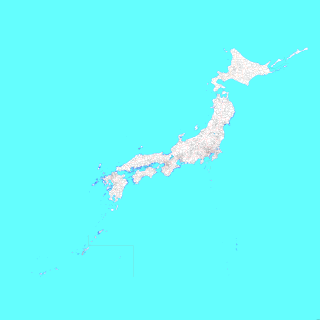Municipalities of Japan
Administrative divisions of Japan From Wikipedia, the free encyclopedia
Japan has three levels of governments: national, prefectural, and municipal. The nation is divided into 47 prefectures. Each prefecture consists of numerous municipalities, with 1,719 in total as of January 2014.[1] There are four types of municipalities in Japan: cities, towns, villages and special wards of Tokyo (ku). In Japanese, this system is known as shikuchōson (市区町村), where each kanji in the word represents one of the four types of municipalities. Some designated cities also have further administrative subdivisions, also known as wards. But, unlike the special wards of Tokyo, these wards are not municipalities.

Status
The status of a municipality, if it is a village, town or city, is decided by the prefectural government. Generally, a village or town can be promoted to a city when its population increases above fifty thousand, and a city can (but need not) be demoted to a town or village when its population decreases below fifty thousand. The least-populated city, Utashinai, Hokkaidō, has a population of merely four thousand, while a town in the same prefecture, Otofuke, Hokkaidō, has nearly forty thousand residents, and the country's largest village Yomitan, Okinawa has a population of 40,517.
The capital city, Tokyo, no longer has city status. Tokyo Prefecture now encompasses 23 special wards, each a city unto itself, as well as many other cities, towns and even villages on the Japanese mainland and outlying islands. Each of the 23 special wards of Tokyo is legally equivalent to a city, though sometimes the 23 special wards as a whole are regarded as one city. For information on the former city of Tokyo, see Tokyo City; for information about present-day Tokyo Prefecture, see Tokyo.
Examples
See List of cities in Japan for a complete list of cities. See also: Core cities of Japan
The following are examples of the 20 designated cities:
- Fukuoka, the most populous city in the Kyūshū region
- Hiroshima, the busy manufacturing city in the Chūgoku region of Honshū
- Kobe, a major port on the Inland Sea, located in the center of Honshū near Osaka
- Kitakyūshū, a city of just under one million inhabitants in Kyūshū
- Kyoto, former capital, historic center and thriving modern city
- Nagoya, center of a major automobile-manufacturing region on the eastern seaboard of Honshū
- Osaka, a vast manufacturing city on the Inland Sea coast of Honshū
- Sapporo, the largest city in Hokkaidō
- Sendai, the principal center of northeast Honshū (also known as the Tōhoku region)
- Yokohama, a port city just south of Tokyo
Non-municipality
The same kanji which designates a town (町) is also sometimes used for addresses of sections of an urban area. In rare cases, a municipal village might even contain a section with the same type of designation. Although the kanji is the same, neither of these individual sections are municipalities unto themselves. Sometimes, the section name is a remnant from gappei, a system where several adjacent communities merge to form a larger municipality, where the old town names are kept for a section of the new city, even though the resulting new city may have a completely different name.
- Subprefectures are branch offices of the prefectures and not municipalities by themselves.
- Districts are not current municipalities but names of groups of towns and villages.
- Provinces are not current municipalities but (almost obsolete) names of geographical regions similar to prefectures.
See also
References
External links
Wikiwand - on
Seamless Wikipedia browsing. On steroids.
